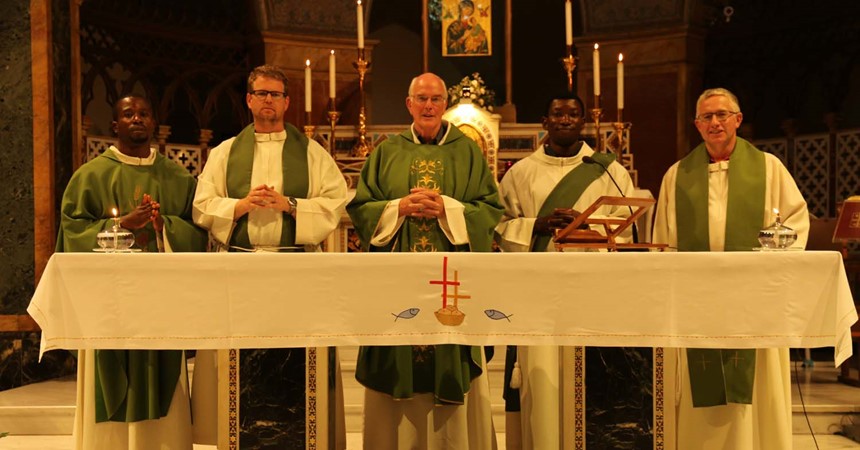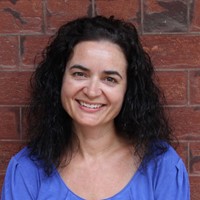We started at St John Lateran Basilica, a magnificent church filled with huge statues of the Apostles. This church honours John the Baptist and John the Evangelist. It is the resting place of Pope Martin V, a pope of the 16th century. There are wooden doors at the entrance that date back to the time of Julius Caesar. It is the first Christian church to be built in Rome and as we explored we walked on the original marble floors.
It is impossible not to be amazed at the ancient history of Rome and each place we visit highlights the fact that we are walking through history.
Across the road from the Basilica is Sancta Sanctorum (The Holy of Holies), home to Scala Santa, the Holy Stairs. These stairs were brought to Rome from Jerusalem around 326 AD by St Helena, mother of Constantine the Great. These 28 stairs can only be ascended by the faithful on their knees. Many of the pilgrims made this climb. At the top of the stairs is an icon of the Holy Saviour, which according to popular medieval tradition was not painted by human hand. This place is the most important sanctuary in Rome.
Many of the pilgrims were excited about our next stop, the Catacombs. During the persecutions, the catacombs were used as places of refuge for the celebration of the Eucharist. They were also the burial ground of 150,000 people. The history of the catacombs is fascinating; how they were built, the link to the way churches were built with altar and grave of the martyr always together, the way people were buried there, dependent on social status.
As our tour guide said, “the architectural history of Rome is a history of recycling” so, just as at the Roman Forum and the Colosseum, we had to rely on our imagination to picture the grand marble floors and art that once decorated some of the graves here. There are eleven miles of tunnels in the catacombs but we only explored a small section. We learned how the graves were decorated with symbols related to resurrection, for example, doves and anchors (for St Peter). Although many graves were opened over the years, from 1932 the catacombs were protected, and today there are 20,000 still intact. The catacombs also contain what is believed to be the first ever painting of St Peter and St Paul, dating back over 1,600 years.
We then drove to St Paul Outside the Walls, resting place of St Paul, who was beheaded not far from the site of the Basilica. It is another magnificent church with medallions of every Pope lining the walls. It is filled with alabaster columns and mosaics. There are glorious gardens in a courtyard area and we had lunch at a café on the grounds.
You could explore Rome for a whole year and not really scratch the surface of the history here. Every statue, painting, fresco and mosaic tells a story.
Our next stop was St Mary Major Basilica which was built in the 5th century. The upper part of the façade is original and includes the highest bell tower in Rome, at 75 metres. The Holy Door of the Basilica was blessed by St John Paul when he was Pope. This church is home to a beautiful statue of the Virgin Mary which was built for the church after WWI. The statue portrays Mary with her arm outstretched and her palm facing forward in a ‘stop’ gesture. She looks sad. Baby Jesus is holding an olive branch. A dove sits at their feet. The statue was meant to express their sadness at the war and their desire for peace and was built in thanksgiving for its end.
Our final destination for the day was the Church of St Alphonsus, a Redemptorist church which houses the original 14th century icon of Our Lady of Perpetual Help. We also celebrated Mass here which was very special given that Our Lady of Perpetual Help is one of the patrons of our diocese.
Bishop Bill, in his homily, spoke about the two key messages about prayer from the scripture readings. First, we should pray directly to God, there’s no need to complicate it. When Jesus taught the ‘Our Father’ to his disciples he was giving them a framework for prayer. It is a series of short prayers asking directly for what we need. Second, we should pray consistently; keep going, keep asking. Bishop Bill spoke about an answer author CS Lewis gave a young man who pondered, ‘Doesn’t God know what we want already?’ and Lewis replied that when we pray it doesn’t change God, it changes us.
“We need to pray with trust and hope; keep it simple and keep it up,” said Bishop Bill.
After Mass some of the pilgrims got off the bus in town to explore the place where St Catherine of Siena’s body is, the Trevi Fountain and the Spanish Steps. The rest of the pilgrims continued back to the hotel for some rest. Many gathered again at the restaurant around the corner from the hotel, Shardana, where we had enjoyed a wonderful meal the night before.
OBSERVATIONS:
We are tired. I know I have said this before, but we’re still tired. Perhaps we’re just subconsciously preparing ourselves for the hectic pace of WYD week. We have good intentions of getting to bed early, but many of us are drawn to the rooftop of our hotel in the evening where we have shared prayer, song, stories and a drink. After experiencing so much together during the day we need to make sense of our adventures and emotions with each other. We need to relax and enjoy each other’s company. Whenever I feel weary during the day I simply look to Sophia Treloar, our youngest pilgrim, who is always wearing a grin from ear to ear; her enthusiasm and joy are infectious. Or I watch or have a chat to our more ‘vintage’ pilgrims, whose tenacity and wisdom are appreciated and admired.
OBSERVATIONS: Rome
“Climbing the Holy Stairs on my knees was the most profound and meaningful experience I have had in my relationship with Jesus. As I was climbing I just felt his love for me and I really love and believe in him. I was just repeating a simple prayer, ‘Jesus, you are with me’ as I climbed. This was the best moment of the pilgrimage for me so far. When I was in the chapel after the climb a sense of peace and calmness came over me.”
Johanna Soo
“The highlight for me was visiting St Paul Outside the Walls, because of my connection with the school where I teach – St Paul’s Primary School, Rutherford. It was wonderful for me to be there to gain that knowledge and be able to share St Paul in a meaningful way with my students and school.”
Phoebe Spencer
OBSERVATIONS: Looking forward
“I’m looking forward to seeing all of our students together in Krakow. I think it will be great to see them focus on their spirituality and enjoy their mateship.”
Michael Turton



































